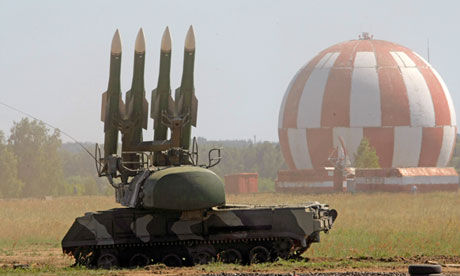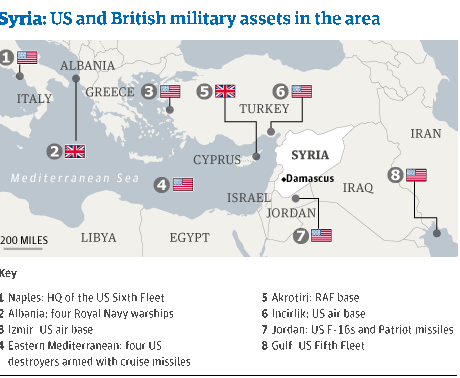With substantial hardware already in region, analysts say first move likely to be show of force without engaging Syria's military
Share 70

Robert Booth and Richard Norton-Taylor
The Guardian, Sunday 25 August 2013 18.19 BST
Russian Buk-M2E air defence missile systems
Any western intervention in Syria would have to contend with its considerable air defences, including Russian Buk-M2E missile systems. Photograph: Mikhail Metzel/AP
The increasingly bellicose statements on Syria coming from London and Washington will sharpen the focus of Monday's meeting of top US, British, French and other generals in the Jordanian capital of Amman.
The summit will be led by General Martin Dempsey, the chairman of the US joint chiefs of staff, and his Jordanian counterpart, and attended by General Sir Nicholas Houghton, the British armed forces chief. It will take place little more than 100 miles from Damascus, where an apparent chemical weapons attack killed hundreds of civilians last week.
Top generals from Germany, Canada, Italy, Saudi Arabia and Qatar are also expected to attend a meeting which will coincide with UN weapons experts visiting the site of the attack in an attempt to determine what happened and who was behind it.
The key players in any possible strike against Syria, widely considered to be the US, Britain and France, already have substantial military muscle in the area. Britain has four warships, the Navy's flagship HMS Bulwark, a helicopter carrier and two frigates off Albania. The US has a group of three destroyers in the eastern Mediterranean, which it has bolstered with a fourth, the USS Mahan. France has Rafale and Mirage jets based in the United Arab Emirates which could potentially reach Syria, though the US airbases at Incirlik and Izmir in Turkey and the RAF base at Akrotiri in Cyprus are more likely launch points for any offensive.
The Ministry of Defence is drawing up attack plans that one well-placed official described as a "Libyan suite of options", a reference to the naval, air and land strategies that were considered in the overthrow of Muammar Gaddafi in 2011. A key difference is the strength of Syria's air defences.

In recent years, Russia is reported to have supplied Damascus with 36 Pantsir mobile surface to air missile systems and at least eight Buk-M2E mobile surface to air missile batteries. The Pantsirs, considered particularly effective against attacking aircraft, feature a combination of 30mm cannon paired with a radar and anti-aircraft missiles all on the same vehicle.
Western options include strikes by Tornado jets equipped with £500,000-a-shot Storm Shadow long-range cruise missiles which can be fired 150 miles from the target, allowing pilots to avoid the need to come within range of Syrian air defences. The US warships in the region are carrying Tomahawk cruise missiles and Washington has F-16 fighter jets and Patriot missile batteries in Jordan.
"President Obama has asked the defence department to prepare options for all contingencies," the US defence secretary, Chuck Hagel, said over the weekend. "We have done that and we are prepared to exercise whatever option, if he decides to employ one of those options."
The question is how to wield western military might against a regime with relatively strong air defences, chemical weapons capabilities and a powerfully ally in Russia. "There are not going to be ground troops, that's for sure," said one British defence official, sounding a widely-held note of caution. Imposing a no-fly zone would need a UN mandate, he added. Such a tactic would anyway be tough to maintain without casualties because Syria's air defences have been recently bolstered by the Russians.
So the first move is likely to be an increased show of force, said Charles Heyman, editor of Armed Forces of the United Kingdom. The allies are already openly moving naval forces closer to Syria, and Heyman said overflying the country with bombers out of reach of surface to air missiles could be next. If Bashar al-Assad is proved to be behind the chemical attack, Heyman believes such sabre rattling would not upset the Russians.
Air surveillance of Assad's troops, conventional artillery and chemical weapons units will already have given a clear picture of the situation on the ground.
"Every spook in the world is listening in to the Syrian units and the people who might be involved in moving chemical weapons around," said Heyman. He added that while the allies are likely to be ready to strike, the best use of military force remains as a deterrent.
Treasuries in London and Washington will also be worried about the cost of war. "The defence secretary, Philip Hammond, will be asking the chancellor for £500m for this operation," he said. The Pentagon is facing a $52bn budget cut in the next financial year.
If strikes were ordered, they would not be against chemical facilities as they are too mobile and present a risk of widespread contamination. Air defences would be hit first, perhaps initially those close to the Turkish border, as a warning shot. Long-range weapons would be used to avoid western casualties.
"If that doesn't work they will start hammering away at the wider Syrian air defences," said Heyman. "That won't be as easy as Libya, but Nato aircraft would be able to take them out in seven days, I believe."
1 comment:
Your style is unique compared to other people I have read stuff from. Thank you for posting when you have the opportunity, guess I will just bookmark this page.
Arun Panchariya in Serbia
Post a Comment